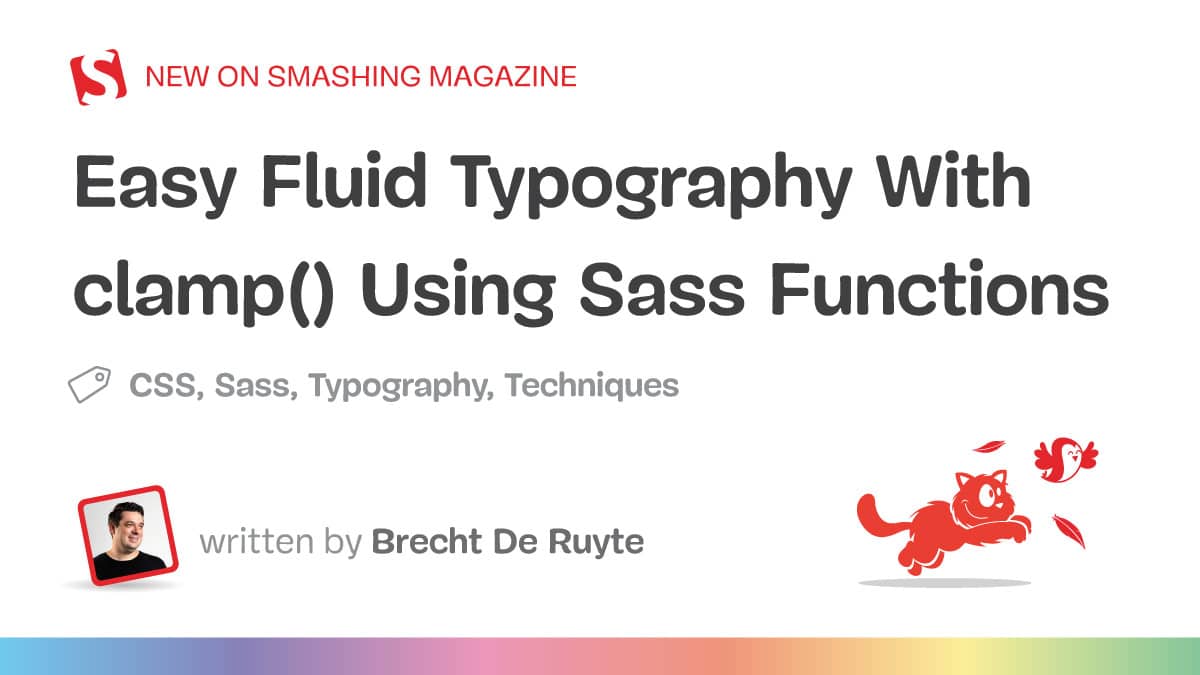
Fluid typography is getting much more fashionable, particularly for the reason that clamp() math operate is offered in each evergreen browser. But when we’re trustworthy, it’s nonetheless a number of arithmetic to attain this. You need to use instruments reminiscent of utopia.fyi, that are incredible. However in massive tasks, it may get messy fairly quick. I’m an enormous fan of readable and maintainable code and all the time need to see what my code is doing at a look. I’m certain there are numerous extra of you want that, so as an alternative of including a full clamp() operate inside our code, perhaps we are able to make this a bit extra readable with Sass.
Why Ought to We Use Fluid Typography?
Normally, when designing for various display screen sizes, we use media queries to find out the font measurement of our typographic components. Though this often provides sufficient management for the extra typical gadgets, it doesn’t cowl the entire display screen sizes.
By utilizing fluid typography, we are able to make the typography scale extra logically between all types of various gadgets.
That is now doable in all evergreen browsers due to the clamp() operate in CSS. It’s excellent for the job and reduces our media question writing, thus saving us a little bit of file measurement alongside the best way.
How Precisely Does This clamp() Operate Work For Typography?
Briefly, the clamp operate seems like this:
clamp([min-bound], [value-preferred], [max-bound]);
This takes into consideration three numbers: a minimal certain, most well-liked worth, and a most certain. By utilizing rem values, we are able to enhance the accessibility a bit, nevertheless it’s nonetheless not 100% foolproof, particularly for exterior browser instruments.
If you would like a extra in-depth rationalization of the maths, I recommend you learn this publish from Adrian Bece “Fashionable Fluid Typography Utilizing CSS Clamp ”.
Nonetheless, there’s a little bit of an issue. If you learn these clamp capabilities inside your CSS, it’s nonetheless onerous to see precisely what is going on. Simply think about a file stuffed with font sizes that appear like this:
clamp(1.44rem, 3.44vw + 0.75rem, 2.81rem)
However with somewhat assist from the sass operate, we are able to make these font sizes way more readable.
What Do We Need To Obtain With This Easy Sass Operate?
Briefly, we need to do one thing like this: Now we have a minimal font measurement, from the second our breakpoint is bigger than 400px, we would like it to scale it to our largest font measurement till the most breakpoint is reached.
The minimal and most font sizes are lined fairly simply. If we would like a minimal font measurement of 16px (or 1rem) and a most font measurement of 32px (or 2rem), we have already got the 2 elements of our clamp operate:
clamp(1rem, [?], 2rem)
Creating A Primary Automated Fluid Operate
That is the place issues get difficult, and I recommend you observe the article by Adrian Bece, who provides an ideal in-depth rationalization of the maths behind this.
Briefly, the equation is the next:
(most font-size – minimal font-size) / (most breakpoint – minimal breakpoint)
Let’s get able to do some arithmetic for this to occur in Sass, so let’s create our fluid-typography.scss operate file and begin by including sass:math and the operate with the values we’ll want:
@operate fluid($min-size, $max-size, $min-breakpoint, $max-breakpoint, $unit: vw) {
}
Now, let’s add the calculation for the slope inside our operate with some sass:math:
$slope: math.div($max-size – $min-size, $max-breakpoint – $min-breakpoint);
}
To get a worth we are able to work with, we’ll have to multiply our slope by 100:
$slope-to-unit: $slope * 100;
All that’s left is for us to search out our intercept to construct the equation. We are able to do that with the next operate:
$intercept: $min-size – $slope * $min-breakpoint;
And at last, return our operate:
If we name the created sass operate in our scss, we must always now get fluid typography:
h1 {
font-size: #{fluid(1rem, 2rem, 25rem, 62.5rem)}
}
A Notice About Models
Typically, we will likely be utilizing a viewport width in relation to fluid typography, so this makes a great default. Nonetheless, there are some instances, particularly when utilizing the clamp() operate for vertical spacing, the place you need to use a viewport top as an alternative of width. When that is desired, we are able to change the outputted unit and use a minimal and most breakpoint for the peak:
h1 {
font-size: #{fluid(1rem, 2rem, 25rem, 62.5rem, vh)}
}
Updating The Operate To Make The Calculations Really feel Extra Pure
We obtained what we’d like, however let’s be trustworthy, more often than not, we’re implementing a design, and it doesn’t really feel pure to go our viewports as rems. So, let’s replace this operate to make use of pixels as a viewport measurement. Whereas we’re at it, let’s replace the font sizes so we are able to use pixel values for all the things. We are going to nonetheless convert them to rem items since these are higher for accessibility.
First, we’ll want an additional operate to calculate our rem values based mostly on a pixel enter.
Notice: This received’t work for those who change your base rem worth.
@operate px-to-rem($px) {
$rems: math.div($px, 16px) * 1rem;
@return $rems;
}
Now we are able to replace our fluid operate to output rem values though it will get pixels as enter. That is the up to date model:
$slope: math.div($max-size – $min-size, $max-breakpoint – $min-breakpoint);
$slope-to-unit: $slope * 100;
$intercept-rem: px-to-rem($min-size – $slope * $min-breakpoint);
$min-size-rem: px-to-rem($min-size);
$max-size-rem: px-to-rem($max-size);
@return clamp(#{$min-size-rem}, #{$slope-to-unit}#{$unit} + #{$intercept-rem}, #{$max-size-rem});
}
Now we are able to use the next enter:
font-size: #{fluid(16px, 32px, 320px, 960px)}
This may consequence within the following:
font-size: clamp(1rem, 2.5vw + 0.5rem, 2rem);
At first look, this appears excellent, however principally that’s as a result of I’ve been utilizing quite simple values. For instance, when clamping to a most worth of 31px as an alternative of 32px, our rem values received’t be so rounded, and our output will get a bit messy.
Enter:
font-size: #{fluid(16px, 31px, 320px, 960px)}
Output:
font-size: clamp(1rem, 2.34375vw + 0.53125rem, 1.9375rem);
In case you’re like me and discover this a bit messy as effectively, we may spherical our values somewhat bit to extend readability and avoid wasting bytes in our ultimate CSS file. Additionally, it would get a bit tedious if we all the time have so as to add the viewport, so why not add some defaults in our operate?
Rounding Our Values And Including Some Defaults
Let’s begin by including a rounding operate to our Sass file. This may take any enter and spherical it to a certain quantity of decimals:
@operate spherical($quantity, $decimals: 0) {
$n: 1;
@if $decimals > 0 {
@for $i from 1 by $decimals {
$n: $n * 10;
}
}
@return math.div(math.spherical($quantity * $n), $n);
}
Now we are able to replace our output values with rounded numbers. Replace the operate accordingly. I might recommend setting not less than two decimals for the output values for essentially the most constant outcomes:
$slope: math.div($max-size – $min-size, $max-breakpoint – $min-breakpoint);
$slope-to-unit: spherical($slope * 100, 2);
$intercept-rem: spherical(px-to-rem($min-size – $slope * $min-breakpoint), 2);
$min-size-rem: spherical(px-to-rem($min-size), 2);
$max-size-rem: spherical(px-to-rem($max-size), 2);
@return clamp(#{$min-size-rem}, #{$slope-to-unit}#{$unit} + #{$intercept-rem}, #{$max-size-rem});
}
Now the identical instance as earlier than will give us a a lot cleaner consequence.
Enter:
font-size: #{fluid(16px, 31px, 320px, 960px)};
Output:
font-size: clamp(1rem, 2.34vw + 0.53rem, 1.94rem);
Including A Default Breakpoint
In case you don’t really feel like repeating your self, you’ll be able to all the time set a default breakpoint to your operate. Attempt updating the operate like this:
$default-max-bp: 960px;
@operate fluid($min-size, $max-size, $min-breakpoint: $default-min-bp, $max-breakpoint: $default-max-bp, $unit: vw) {
// …
}
Now, we don’t have to repeat these viewports on a regular basis. We are able to nonetheless add a customized breakpoint however a easy enter reminiscent of:
font-size: #{fluid(16px, 31px)};
Will nonetheless lead to:
font-size: clamp(1rem, 2.34vw + 0.53rem, 1.94rem);
Right here is the total operate:
$default-min-bp: 320px;
$default-max-bp: 960px;
@operate spherical($quantity, $decimals: 0) {
$n: 1;
@if $decimals > 0 {
@for $i from 1 by $decimals {
$n: $n * 10;
}
}
@return math.div(math.spherical($quantity * $n), $n);
}
@operate px-to-rem($px) {
$rems: math.div($px, 16px) * 1rem;
@return $rems;
}
@operate fluid($min-size, $max-size, $min-breakpoint: $default-min-bp, $max-breakpoint: $default-max-bp, $unit: vw) {
$slope: math.div($max-size – $min-size, $max-breakpoint – $min-breakpoint);
$slope-to-unit: spherical($slope * 100, 2);
$intercept-rem: spherical(px-to-rem($min-size – $slope * $min-breakpoint), 2);
$min-size-rem: spherical(px-to-rem($min-size), 2);
$max-size-rem: spherical(px-to-rem($max-size), 2);
@return clamp(#{$min-size-rem}, #{$slope-to-unit}#{$unit} + #{$intercept-rem}, #{$max-size-rem});
}
A Closing Notice: Be A Blissful Clamper For All customers Out There
In case you adopted this little tutorial and have been amazed by it, you would possibly need to add this clamp() technique for all the things, however there is a crucial facet notice in relation to accessibility.
Notice: If you use vw items or restrict how massive textual content can get with clamp(), there’s a likelihood a person could also be unable to scale the textual content to 200% of its unique measurement.
If that occurs, it’s WCAG failure. As Adrian Bece talked about, it’s not 100% foolproof. Adrian Roselli has written some examples on this, which you would possibly discover attention-grabbing.
We are able to use this technique at present due to the nice browser help. By being sensible on the utilization, I’m certain it may be an exquisite addition to your upcoming venture or as an improve to a earlier one.



Subscribe to MarketingSolution.
Receive web development discounts & web design tutorials.
Now! Lets GROW Together!